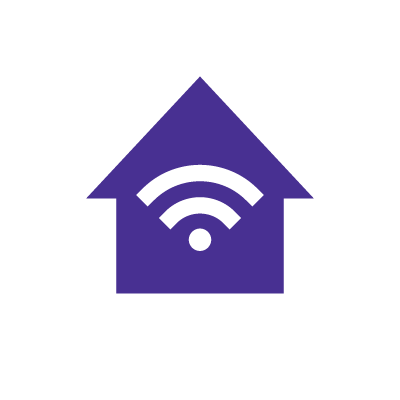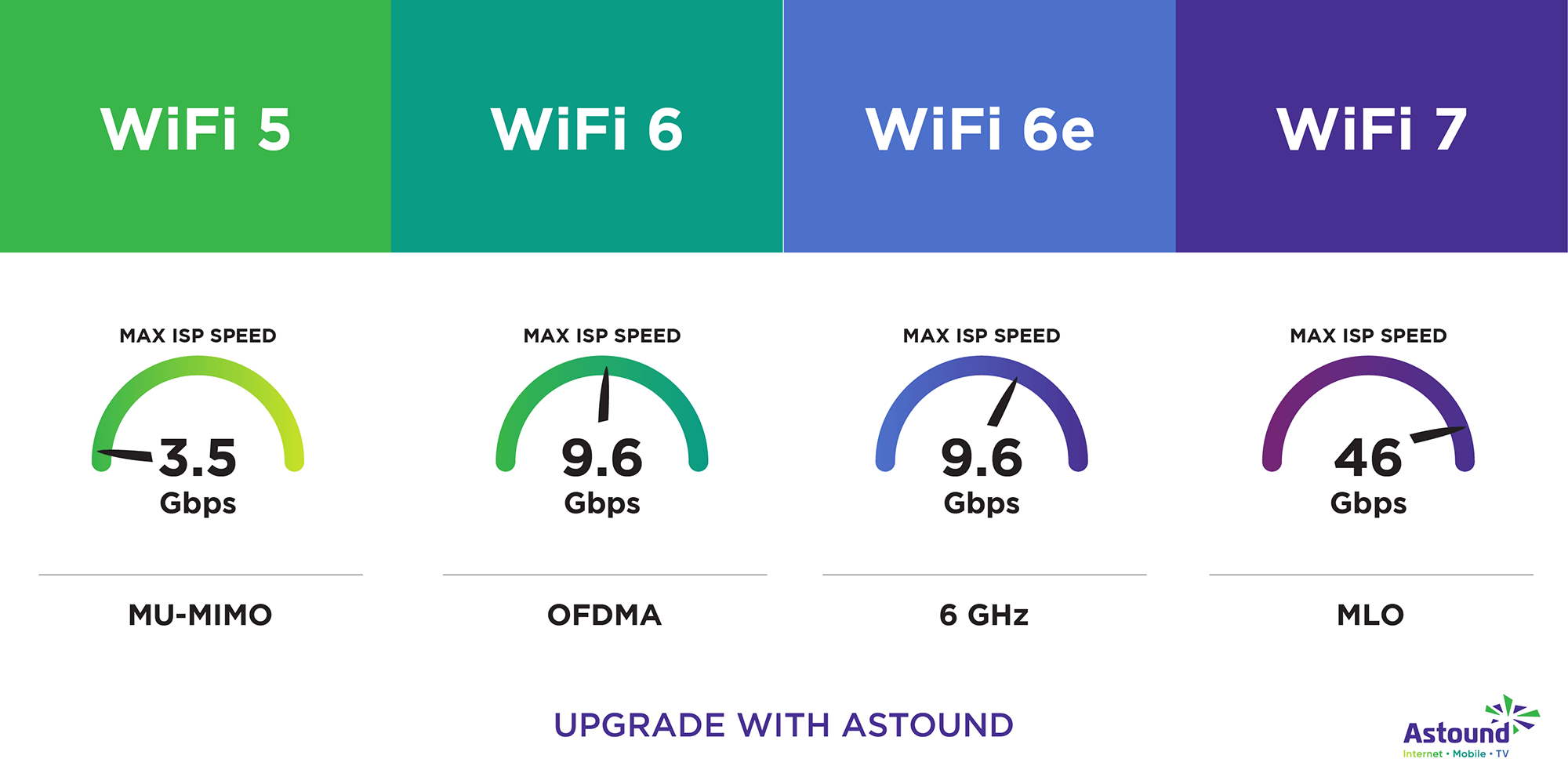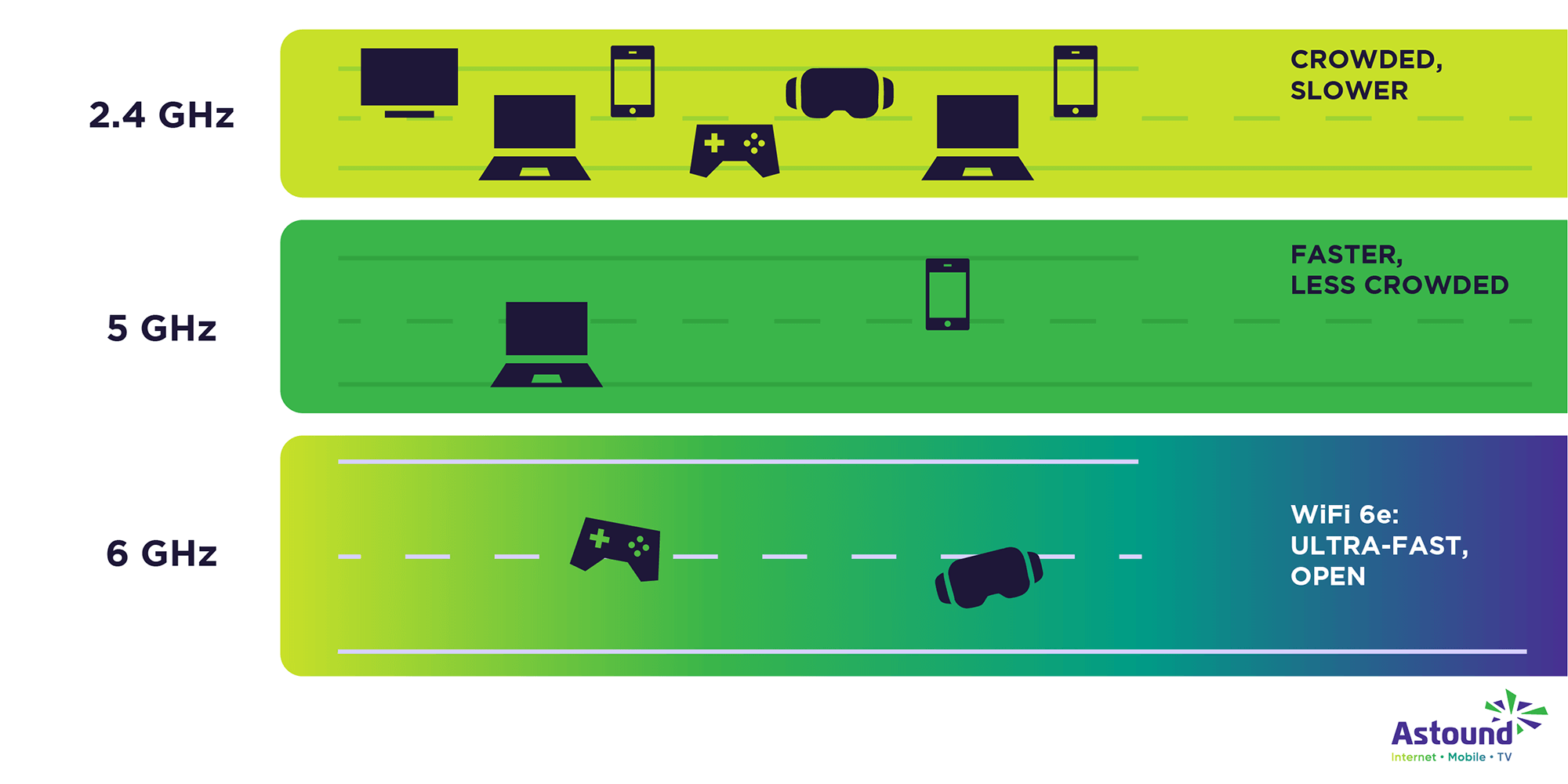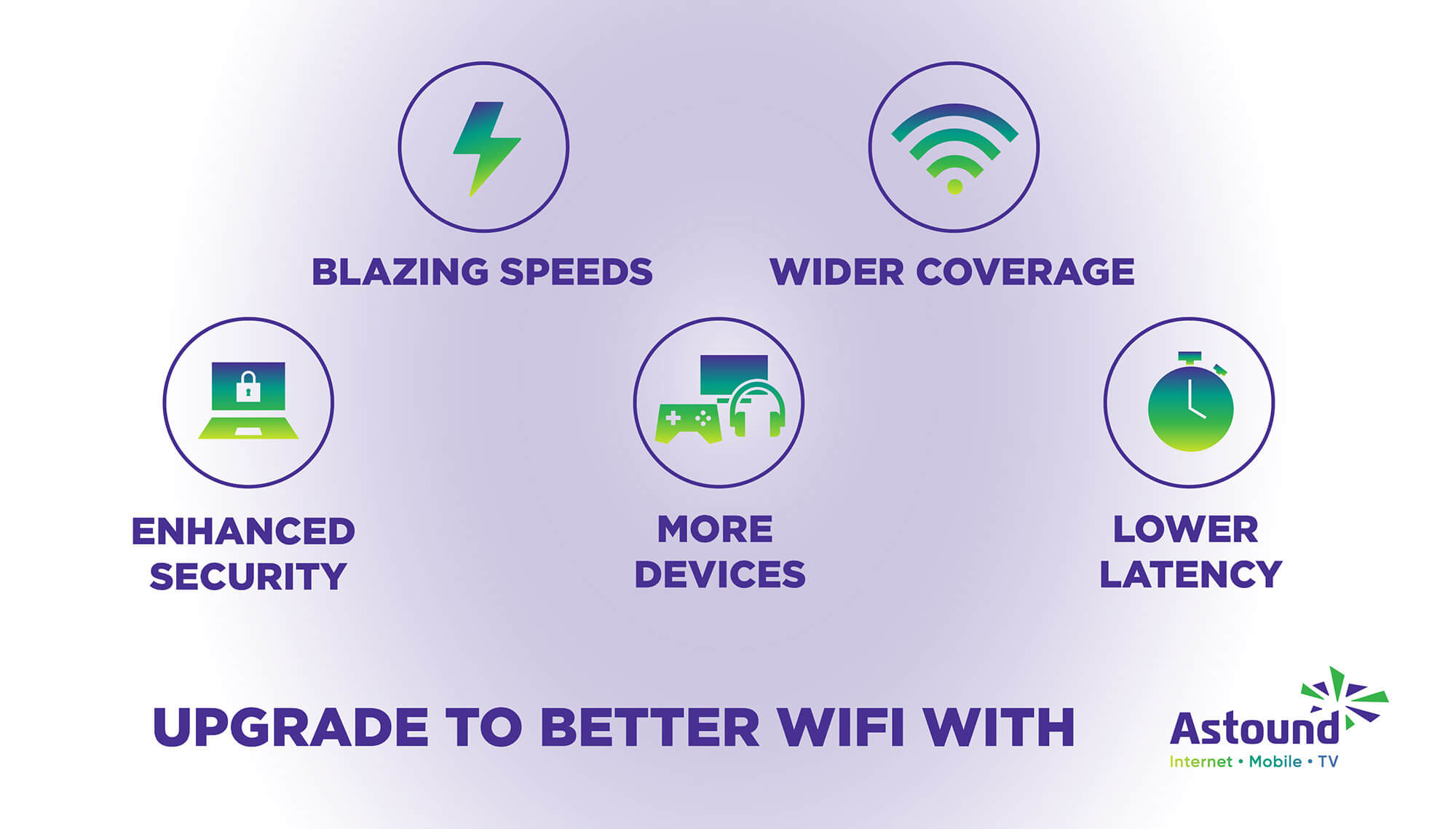WiFi 7 vs. WiFi 6 vs. WiFi 5: What's The Difference?

Technological advancements in wireless networking have resulted in the development of different WiFi standards, including WiFi 5, WiFi 6 and the latest iteration, WiFi 7.
This article will highlight the significant differences between WiFi 7, WiFi 6 and WiFi 5 to provide a clear understanding of each WiFi standard’s advancements and capabilities.
What you'll learn:
- WiFi standards compared
- WiFi differences explained
- WiFi 5 — features and device
- WiFi 6 — features and devices
- WiFi 6e — features and devices
- WiFi 7 — features and devices
- Benefits of upgrading your WiFi network
- When should you upgrade your WiFi?
- Conclusion
- Frequently asked questions
- Looking for more topics?
WiFi that just works!
WiFi plans for any home
Tiny, large or somewhere in between; find WiFi coverage to fit any space. Blanket your entire home with a fast and ultra‑reliable connection.

WiFi standards compared
The table below shows the major differences between WiFi 5, WiFi 6, WiFi 6e and WiFi 7.
| WiFi 5 (802.11ac) | WiFi 6 (802.11ax) | WiFi 6e (802.11ax) | WiFi 7 (802.11be) | |
| Frequency |
5 GHz | 2.4 GHz and 5GHz | 2.4 GHz, 5 GHz and 6 GHz | 2.4 GHz, 5 GHz and 6 GHz |
| Bandwidth (Channels) | 20, 40, 80, 80+80, 160MHz | 20, 40, 80, 80+80, 160MHz | 20, 40, 80, 80+80, 160MHz | 20, 40, 80, 80+80, 160, 320MHz |
| Access |
OFDM | OFDMA | OFDMA | OFDMA |
| Modulation |
256-QAM | 1024-QAM | 1024-QAM | 4K-QAM |
| Antenna |
DL MU-MIMO (4 x 4) | DL + UL MU-MIMO (8 x 8) | DL + UL MU-MIMO (8 x 8) | DL + UL MU-MIMO (8 x 8) |
| Security |
WPA and WPA2 | WPA3 | WPA3 | WPA3 |

WiFi differences explained
Here’s a breakdown of how WiFi 5, 6, 6e and 7 compare in terms of speed, range, device support and use cases.
WiFi 5 vs. WiFi 6
WiFi 6 delivers speeds of up to 9.6 Gbps compared to WiFi 5’s 3.5 Gbps, delivering faster speeds than its predecessor. Its dual band frequency support for 2.4 GHz and 5 GHz, compared to WiFi 5’s 5 GHz, increases device capacity and range while reducing signal congestion. It’s ideal for households with multiple connected devices streaming and gaming simultaneously.
WiFi 5 vs. WiFi 7
WiFi 7 is a significant leap from WiFi 5, offering ultra-fast speeds of up to 46 Gbps, reduced latency and wider bandwidth via the 320 MHz channels. Its tri-band frequency support increases its device capacity and range. WiFi 7 is ideal for data-heavy tasks like virtual reality, 4K/8K streaming and simultaneous high-speed downloads across multiple devices.
WiFi 6 vs. WiFi 6e
WiFi 6e extends WiFi 6 by adding the 6 GHz frequency band, which offers lower latency, less signal interference and increased bandwidth. While both standards offer similar speeds, the 6 GHz frequency band increases device capacity and reduces congestion by supporting additional WiFi 6e-specific devices. Thus, it makes WiFi 6e ideal for bandwidth-intensive applications like online gaming, 4K/8K streaming, video conferencing and virtual reality.
WiFi 6 vs. WiFi 7
WiFi 7 offers much higher speeds, up to 46 Gbps, compared to WiFi 6’s 9.6 Gbps. Its 320 MHz channels provide more bandwidth and device support, accommodating simultaneous connections and data-intensive applications across multiple users and devices.
WiFi 5
WiFi 5, also known as 802.11ac, is the fifth generation of WiFi standards. It was introduced in 2013 by the WiFi Alliance. It primarily operates on the 5 GHz frequency band, providing better data transfer speeds than its predecessor, WiFi 4 (802.11n), which functions on both the 2.4 GHz and 5 GHz bands. The 5 GHz band adds more channels and bandwidth, increasing device capacity and offering less signal interference for stable connections.
Features
Key WiFi 5 features include:
- WiFi 5 provides faster speed transfers than previous standards, with theoretical speeds of up to 3.5 Gbps. These speeds depend on the 256-QAM (Quadrature Amplitude Modulation) technology, which varies the phase and amplitude of radio signals to increase the amount of data transmitted over the same bandwidth. The higher data speeds enable WiFi 5 to support bandwidth-intensive applications and improve overall network performance.
- WiFi 5 implements Orthogonal Frequency-Division Multiplexing (OFDM) technology for network access control. This technology efficiently handles data transmission across several channels to optimize bandwidth and reduce interference.
- WiFi 5 utilizes Multi-User Multiple Input/Multiple Output (MU-MIMO) technology, which allows a WiFi access point (AP) to connect with several devices concurrently by dividing the available bandwidth into separate streams. MU-MIMO technology enables spectrum efficiency to serve multiple users simultaneously, reducing signal wait time and increasing device capacity.
- MU-MIMO in WiFi 5 enables beamforming, which directs signals toward devices instead of broadcasting them in all directions. Beamforming improves signal quality and allows the handling of multiple devices simultaneously.
- WiFi 5 supports the WPA and WPA2 network security protocols for security. However, these protocols have several vulnerabilities, such as dictionary attacks that enable hackers to predict an encrypted password.
Device compatibility
WiFi 5 has been around for a long time, making it widely adopted and compatible with most modern devices. WiFi 5 is also backward-compatible, meaning that older devices compatible with previous standards can connect to WiFi 5. This design ensures WiFi 5 has broad compatibility to connect seamlessly with devices across older WiFi generations.
FIBER-POWERED GIG INTERNET
Gig+ speeds, unbeatable value
Get Gig speeds up to 1500* Mbps starting at $60/mo on Astound’s ultra-reliable fiber-powered‡ network.

WiFi 6
WiFi 6, also known as 802.11ax, is the sixth generation of WiFi standards released by the WiFi Alliance in 2019. It significantly improves speed, device capacity, security and latency compared to WiFi 5.
Features
Some of the key features and improvements WiFi 6 provides include:
- WiFi 6 operates on a dual-band frequency, supporting 2.4 GHz and 5 GHz frequency bands. The dual-band frequency allows more data transmission as it adds more channels, which results in more bandwidth, higher data transfer speeds and less signal interference. The increased bandwidth and less signal interference enable it to handle bandwidth-intensive activities like online gaming and streaming 4K/8K videos.
- WiFi 6 provides theoretical speeds of up to 9.6 Gbps, especially in congested networks. It uses 1024-QAM modulation, which increases spectral efficiency and enables faster WiFi speeds, 25% faster than WiFi 5. 1024-QAM modulation is ideal for avid gamers and work-from-home tasks such as large file transfers and video conferences.
- WiFi 6 supports WPA3, which is the latest security protocol.
- WiFi 6 offers a battery conservation feature for WiFi devices using Target Wake Time technology. The feature extends battery life by allowing devices to control when and how frequently they wake up to receive and send data while preventing network congestion.
- WiFi 6 features MU-MIMO and OFDMA technologies, which allow for more simultaneous connections while minimizing bandwidth competition.
- WiFi 6 is backward-compatible with previous WiFi standards. Older devices can connect to WiFi 6, but the WiFi performance will be limited to what the device is compatible with.
Device compatibility
Since WiFi 6 has been around since 2019, most modern WiFi devices like routers, laptops, smartphones, tablets and smart home devices, are compatible with WiFi 6 standards to ensure an improved WiFi experience.
A wide range of high-profile devices support WiFi 6, including flagship models across smartphones, laptops, tablets and other connected tech. These include:
Mobile Phones
- Huawei P40 Pro
- iPhone models from the iPhone 11 series to the latest iPhone 16 series.
- Samsung Galaxy S20 to the latest S25 series.
- Google Pixel series (Google Pixel 6 to Google Pixel 9)
- LG V60 ThinQ
- Motorola Edge+ and Edge 50 series
- OnePlus 8 series to latest OnePlus 13 series
- Samsung Galaxy Note 10 series
- Samsung Galaxy S20
- Samsung Galaxy Z series
- LG V60 ThinQ
- Nothing Phone 2 series
Laptops
- Asus Chromebook Flip c436
- Apple MacBook Air and Pro series (2020 to 2025)
- Dell XPS 13 (2020, 2023) to XPS 15 (2024) series
- HP Spectre x360
- Lenovo Yoga 7i, 9i IdeaPad and ThinkPad X1 Carbon series
- LG Gram 17
- Microsoft Surface Laptop Go
- Acer Swift X 14
- MSI Prestige 16 AI Studio
Confirm with the manufacturer’s website to check which device supports WiFi 6 before purchasing. While WiFi 6 is backward-compatible, non-compatible devices won’t enjoy the full benefits that WiFi 6 offers.
WiFi 6e
WiFi 6e is an upgraded WiFi 6 that introduces significant improvements over WiFi 6. It was announced in 2020 and has key features and enhancements compared to previous WiFi generations.
Features
- WiFi 6e extends to the 6 GHz frequency band, in addition to the 2.4 GHz and 5 GHz bands supported by WiFi 6. The 6 GHz frequency adds additional channels and a 1200 MHz spectrum, providing more bandwidth, increasing device capacity, lessening channel congestion and lowering latency, especially in congested environments with multiple connected devices.
- WiFi 6e leverages WiFi 6’s technology, such as OFDMA, MU-MIMO and 1024-QAM, while expanding the spectrum’s availability. These technologies enable simultaneous device connections, reduced interference and faster data transfers that are ideal for bandwidth-intensive applications like online gaming, 4K/8K video streaming, teleconferencing and virtual reality (VR).
- WiFi 6e’s 6 GHz is only compatible with WiFi 6e-enabled devices. This exclusivity means that only WiFi 6e devices can fully enjoy the benefits of 6 GHz extensive bandwidth, faster speeds and less interference.
- It implements the latest WPA3 security protocol for networks.
- Despite the 6 GHz band being higher than the 2.4 and 5 GHz bands, it has a shorter range limited to same-room or next-room environments. When you leave the 6 GHz coverage, the router switches you to the 5 GHz or 2.4 GHz range.

Device compatibility
As WiFi 6e becomes mainstream in the market, device manufacturers are swiftly adopting the WiFi technology across various sectors. Some of the notable examples of devices that are compatible with WiFi 6e include:
Smartphones
-
- Google Pixel 6 and 6 Pro
- Google Pixel 7 series
- Samsung Galaxy S22 Ultra
- Samsung Galaxy S23 series
- Samsung Galaxy Z Fold4 to the latest Galaxy Z Fold6
- Samsung Galaxy Z Flip4 to Flip6
- Asus ROG Phone 6 series
- Asus ZenFone 8 and Asus ZenFone 9
Laptops
-
- Apple MacBook Pro 14-inch and 16-inch (2023, M2 Pro/Max)
- HP Spectre x360 16 (2022–2023)
- Asus ZenBook Duo 14 UX482 (2022)
- Lenovo ThinkPad X1 Extreme Series
- Dell XPS 13 Plus (2023)
- Lenovo Legion 7i Gen 8 (2023)
- Acer Predator Triton 500 SE (PT516-52s)
- Acer Predator Helios 300 (PH315-55)
Tablets
- Apple iPad Pro 11-inch (4th generation, 2022; 5th generation, 2024)
- Apple iPad Pro 12.9-inch (6th generation, 2022)
- Apple iPad Pro 13-inch (7th generation, 2024)
- Apple iPad Air (5th generation, 2022)
- Samsung Galaxy Tab S8, S8+, S8 Ultra
- Samsung Galaxy Tab S9, S9+, S9 Ultra
- Apple iPad Air M4 (5th generation)
- Apple
- Apple iPad Pro 13-inch (7th generation)
- Galaxy Tab S8 to S9 series
Routers
- Netgear Nighthawk AX1800
- TP-Link Archer AX73
- Asus RT-AX89X
- Netgear Nighthawk RAXE300, RAXE500
- Netgear Orbi RBKE963 (Mesh)
- Linksys Atlas WiFi 6E (Mesh)
Gaming consoles
- Xbox Series X and Xbox Series S
- PlayStation 5 2020 and 2023 Slim Model
Smart TVs
- Samsung QN900B
- LG OLED C2
- Sony A95L QD-OLED (2023)
Remember to check the manufacturer’s website to see if the devices are designed to support the WiFi 6e standard before purchase.
Find your speed
What speed do you need?
Maybe you just need the essentials—or maybe you need to unleash the ultimate internet speed. Explore your options to get the best experience for every device in your home.

WiFi 7
WiFi 7, also known as 802.11be, is the seventh and most recent WiFi standard, released by the WiFi Alliance in early January 2024. It significantly improves wireless speeds and reduces latency, marking a major advancement over previous generations’ WiFi performance.
Features
Significant features WiFi 7 provides include:
- 320 MHz channels that pack more data for transmission and offer a large bandwidth to boost data throughput and device capacity. The added channels can accommodate multiple simultaneous connections and handle data-heavy applications.
- 4K-QAM modulation that increases data transmission rates compared to WiFi 6’s 1K-QAM. WiFi 7 offers speeds up to 46 Gbps, compared to 9.6 Gbps in WiFi 6 and 6e and 3.5 Gbps in WiFi 5.
- Tri-band data transmission as WiFi 7 operates on the 2.4 GHz, 5 GHz and 6 GHz frequency bands.
- Multi-Link Operation (MLO) technology enables devices to connect and transmit data simultaneously over different channels within the same or multiple frequency bands, increasing overall data throughput. If a channel or band is congested, MLO switches to another, maintaining a stable and efficient connection.
- It enhances spectrum efficiency and interference mitigation using multiple resource units (MRUs). A user can manage bandwidth allocation by assigning resources to a specific device depending on its requirements.
- Power-saving features for devices using TWT technology and Spatial Multiplexing Power Save (SMPS) to ensure devices maintain high-performance levels while consuming less power.
- WiFi 7 offers preamble puncturing, which enables spectrum efficiency by avoiding congested channels or channels with interference. Preamble puncturing allows for high data transmission rates and efficient channel usage, even in congested or interference-heavy environments.
- WiFi 7 is backward-compatible with previous WiFi generations, just like WiFi 6. However, your devices must be compatible with WiFi 7 to fully enjoy the improved speeds, low latency and higher bandwidth WiFi 7 provides.
Device compatibility
Like any emerging technology, it will take time for WiFi 7-compatible devices to hit the market. Most devices in homes and available for sale today aren’t WiFi 7-compatible so consumers cannot reap the benefits of this latest technology.
However, some WiFi 7-compatible devices have emerged, mainly WiFi routers. Soon, we can expect to see more WiFi 7-enabled devices such as laptops, smartphones and other smart devices.
Routers
Some WiFi 7-compatible routers include:
Mobile phones
Flagship phones that are compatible with WiFi 7 include:
- Apple iPhone 16 series
- Samsung Galaxy S24 Ultra (2024)
- OnePlus 11 (2023)
- OnePlus Ace 2 Pro (2023)
- OnePlus 13 series
- Motorola Edge +
- Google Pixel 9 series
- Google Pixel 8 Pro
Laptops
- Microsoft Surface 7th Edition series (Copilot+ PC)
- Microsoft Surface Pro 11th Edition series (Copilot+ PC)
- Lenovo Yoga Book 9i series
- Lenovo ThinkPad X9 Aura Edition series
- Dell Alienware m16 and x16 2024 series
- Asus ROG Zephyrus G14 and G16 2025 series
- HP Omen Transcend 14 2024
- HP Envy x360 series

Mesh WiFi with
eero Secure
Enhanced Whole Home WiFi uses multiple routers (or eeros®) to boost range, speed, and stability, while eero Secure, included at no extra cost, offers parental controls, ad blocking, and internet backup for constant connectivity.
Benefits of upgrading your network
Some of the benefits that you enjoy when you decide to upgrade your WiFi network include:
- Speed: Each newer WiFi standard supports faster WiFi speeds, which makes high-speed activities like online gaming, high-quality video streaming and file uploads and downloads quicker and smoother.
- Extended range and coverage: Upgrading your WiFi standard provides better range and coverage while maintaining high network performance. Newer WiFi standards contain features such as beamforming and mesh WiFi support, which extend WiFi signals and reduce dead zones in your home.
- Lower latency: Lower latency in newer WiFi standards due to less signal interference improves your general WiFi experience. Real-time applications like online gaming and video conferencing become smoother and more enjoyable as it takes less time for data to be transmitted.
- Improved device capacity: Newer WiFi standards like WiFi 6e and WiFi 7 support 6 GHz bands that increase device capacity, handling more WiFi devices simultaneously. Improved device capacity enables multiple users to use the internet concurrently in a household without compromising performance.
- Enhanced security: Upgraded WiFi networks have improved features like WPA3 encryption. WPA3 is the latest network security protocol that provides better protection against cyber threats.
Upgrading your WiFi network improves your online experience and meets the growing demand for high-speed, reliable and secure internet connectivity for your needs.


eero Plus
eero Plus protects your family online with a password manager to safely create, store and share passwords, virus and malware protection and a VPN that lets you browse the web safely and securely.
When should you upgrade your WiFi?
As you add more WiFi devices to the network and the demand for faster and more stable WiFi speeds increases, knowing when to upgrade the WiFi and router becomes imperative. Let’s look at some circumstances that indicate the need for an upgrade.
- Device compatibility: Most modern devices support the latest WiFi standards and benefit the most from their advantages and features. Upgrading your WiFi router guarantees that all new devices can connect seamlessly and fully use their features.
- Usage: If you are an avid gamer, 4K or 8K streamer or work from home, you require more bandwidth, faster speeds and lower latency. Upgrading to a more advanced WiFi standard provides faster speeds, more bandwidth and lower latency to handle these intensive activities with ease and reliability.
- Cost implications: Upgrading might seem like an added expense as it requires a new router that may be costly. However, newer WiFi standards are future-proof as some are backward-compatible (WiFi 6 and 7), and as you buy compatible WiFi devices in the future, you will eliminate the need to replace your WiFi setup to accommodate them.
- Network/bandwidth congestion: As you add new devices to your network, outdated routers using older WiFi standards may struggle with network congestion, leading to slow performance. Newer WiFi standards offer better bandwidth management and increased device capacity, supporting multiple devices simultaneously without affecting performance.
- Poor WiFi coverage: If your current WiFi network cannot cover all areas of your house, consider upgrading your router to a newer model that supports the latest WiFi standard and pairing it with a mesh WiFi system. The mesh system extends WiFi coverage across your house and maintains improved performance throughout.
Conclusion
The evolution from WiFi 5 to WiFi 7 represents significant developments in wireless technology, providing major improvements in speed, capacity, efficiency and security.
WiFi 5 paved the way for present WiFi capabilities with faster speeds and dual-band support. WiFi 6 built upon WiFi 5’s technology by improving speeds up to 9.6 Gbps, lowering latency and implementing MU-MIMO and OFDMA technologies that increased device capacity and network efficiency. WiFi 6e offers tri-band frequency by introducing the 6 GHz band, which provides additional channels for more bandwidth and less signal interference.
WiFi 7 is the latest standard, significantly improving speeds up to 46 Gbps and implementing newer technologies. MLO, MRU and preamble puncturing maximize spectral efficiency, increase device capacity and improve overall network performance.
Upgrading your WiFi provides benefits such as faster speeds, extended coverage, enhanced security, lower latency and overall efficiency, making it a viable choice for various uses, including online gaming, remote work and home automation.
However, consider factors such as device compatibility, internet usage, cost implications and network congestion before upgrading.
If your home WiFi connection uses an older standard, consider upgrading to newer WiFi standards by choosing the right ISP for network improvements and efficiency. Astound provides a robust internet connection that will improve your overall internet experience.
Build your plan
Your perfect plan is just a click away
Get the speeds, WiFi, mobile and TV plans you need all at an affordable price. Bundle your services with Astound and see how much you can save.

Frequently asked questions
Is WiFi 5 outdated?
While WiFi 5 is not obsolete and is still used by various WiFi devices, it offers slower speeds, higher latency and less device capacity than the newer standards for today’s bandwidth-intensive activities.
Is it worth upgrading from WiFi 5 to WiFi 6?
Yes, upgrading from WiFi 5 to WiFi 6 significantly improves WiFi speeds, network range, security and device capacity. This is great for households with multiple devices that stream, game or work from home.
Does WiFi 6 improve range?
WiFi 6 improves range, especially in crowded environments, by using technologies such as beamforming and OFDMA. Its dual-band support also helps improve range, with the 2.4 GHz band covering a wide area, supporting devices further away, while the 5 GHz band covers devices closer to the router.
Is WiFi 6e better than WiFi 6?
WiFi 6e is better than WiFi 6 as it introduces the 6 GHz band that offers more bandwidth, less signal interference and reduced congestion. Its additional bandwidth makes it ideal for bandwidth-intensive applications like 4K/8K streaming, gaming and virtual reality, especially in crowded network environments.
Is WiFi 7 faster than Ethernet?
Theoretically, WiFi 7 is faster than many Ethernet connections, with support for speeds up to 46 Gbps. This surpasses common Ethernet standards like Cat5e (up to 1 Gbps), Cat6 and Cat7 (up to 10 Gbps) and even Cat8 (up to 40 Gbps). However, real-world WiFi 7 speeds depend on optimal conditions, compatible devices and minimal interference. Ethernet, due to its wired connection, typically provides more consistent performance and lower latency.
Is WiFi 7 worth it over WiFi 6?
WiFi 7 is worth it if you need very fast speeds, the lowest latency and great device support for very demanding bandwidth and data-intensive applications. For most households, WiFi 6 and WiFi 6e meet the demand for most online activities. You should upgrade if you are future-proofing or have very high-performance requirements.
Do WiFi 6, 6e and 7 work with older devices?
Yes, all three standards are backward compatible with older WiFi devices. WiFi 6 is dual-band, while WiFi 6e and 7 are tri-band, meaning they can work with older devices supporting the previous standards. However, those devices won’t fully benefit from the faster speeds, lower latency and device capacity offered by the newer standards.
Create the perfect bundle
Get the speed, WiFi, mobile and TV that’s just right for you.
*Internet speeds may vary & are not guaranteed. Certain equipment may be required to reach advertised speeds. DOCSIS 3.1 modem with 2.5GE physical LAN port is required for 1 Gigabit speeds and higher. See astound.com/yourspeed for why speeds may vary. To view Astound’s FCC Network Management Disclosure see astound.com/policies-disclaimers. Limited time offer, subject to change without notice. Advertised promotional price valid for duration of the stated promotional period from time of service activation. Regular rates apply after promotional period ends. Equipment not included and is extra. Modem required for Internet service. Enhanced Wi-Fi or Whole Home Wi-Fi (eero) not included and is add’l. Offer includes a monthly discount for enrollment in both automatic payments (autopay) & paperless billing (e-bill). Discount of $10 applies with automated bank account deduction or a discount of $5 applies with automated credit/debit card payment. Valid email address required. Must complete enrollment in autopay and e-bill within 30-days of placing the order. Without enrollment, the discount does not apply. Discount appears on bill within 3 bill cycles after enrolling. If either autopay or e-bill is canceled, services are changed, or the account is not in good standing, then the monthly discount will be discontinued. Offer valid only for new residential Astound customers or previous customers with an account in good standing who have not had Astound service within the last 60 days. Any add’l services, equipment, premium channels & other tiers of service are subject to an add’l charge & regular increases. A one-time activation fee of $14.99 (in addition to any installation fees) will be charged & is subject to change. Add’l fees apply for taxes & surcharges, and are subject to change. WA RESIDENTS: unless otherwise specified, price does not include a 2% Regulatory Administration Fee. For details about taxes, fees & surcharges visit astound.com/fees. No early termination fees apply in the event service is terminated in advance of the promotional end date. Customer is responsible for any accrued service charges in the event service is canceled. Subject to credit check. Not all services & speeds are available in all areas. A multi-product discount may be available to qualifying addresses with a subscription to mobile, TV, and 600 Mbps Internet or higher. Discounts will be reflected in your order cart at time of purchase, if available. Other restrictions may apply. All services are governed by the Astound Customer Terms & Conditions that can be found at astound.com/policies-disclaimers. © 2025 Radiate HoldCo, LLC d/b/a Astound Broadband. All rights reserved.
While we have made every attempt to ensure that the information contained in this site has been obtained from reliable sources, Astound is not responsible for any errors or omissions, or for the results obtained from the use of this information. All information in this site is provided “as is”, with no guarantee of completeness, accuracy, timeliness and without warranty of any kind, express or implied, including, but not limited to warranties of performance, merchantability and fitness for a particular purpose. Certain links in this site connect to other websites maintained by third parties over whom Astound has no control. Astound makes no representations as to the accuracy or any other aspect of information contained in other websites.
AT&T Internet Air, T-Mobile 5G home internet and Verizon 5G home internet details were pulled from their respective websites on December 5, 2023. *Internet speeds may vary & are not guaranteed. Certain equipment may be required to reach advertised speeds. Limited time offer, subject to change without notice. Advertised promotional pricing valid for 12 or 24 months from service start date, subject to change thereafter. Astound offers month-to-month service with base discounted introductory rate tiers. Prior to the end of any discounted rate tier, subscribers receive a notice informing them of the end of the discounted rate tier and providing information about the next discounted rate tier. Unless otherwise specified, 2-year price lock only available w/ promo internet pricing for speeds of 500 Mbps or greater. Additional fees apply for taxes and surcharges, and are subject to change. For details about fees & taxes visit astound.com/fees. Offer includes a monthly discount for enrollment in both automatic payments (autopay) & paperless billing (e-bill). Discount of $10 applies with automated bank account deduction or a discount of $5 applies with automated credit/debit card payment. Valid email address required. Must complete enrollment in autopay and e-bill within 30-days of placing the order. Without enrollment, the discount does not apply. Discount appears on bill within 3 bill cycles after enrolling. If either autopay or e-bill is canceled, services are changed, or the account is not in good standing, then the monthly discount will be discontinued.
**Source
eero Plus is available for an additional $9.99/month and requires subscription to whole home WiFi powered by eero.



















